Financial Management: Activity Based Costing Application at Unilever
VerifiedAdded on 2023/06/10
|17
|1379
|456
Report
AI Summary
This report provides a detailed analysis of Activity Based Costing (ABC) and its application within Unilever Plc's financial management framework. It begins by defining ABC and comparing it with other costing systems like absorption, process, and job costing. The report then elaborates on how ABC can be implemented at Unilever, focusing on resource drivers, activities, activity drivers, cost objects, and activity cost drivers specific to personal and household product lines. It highlights the advantages of using ABC, such as realistic cost assessment and improved efficiency evaluation, as well as its disadvantages, including complexity and resource intensity. A comparison with traditional costing techniques is presented, emphasizing the benefits of ABC in terms of accurate cost allocation and understanding overheads. The report concludes by referencing several academic sources that support the analysis of ABC in organizational settings.

FINANCIAL MANAGEMENT
AND DECISION
Unilever Plc
AND DECISION
Unilever Plc
Paraphrase This Document
Need a fresh take? Get an instant paraphrase of this document with our AI Paraphraser
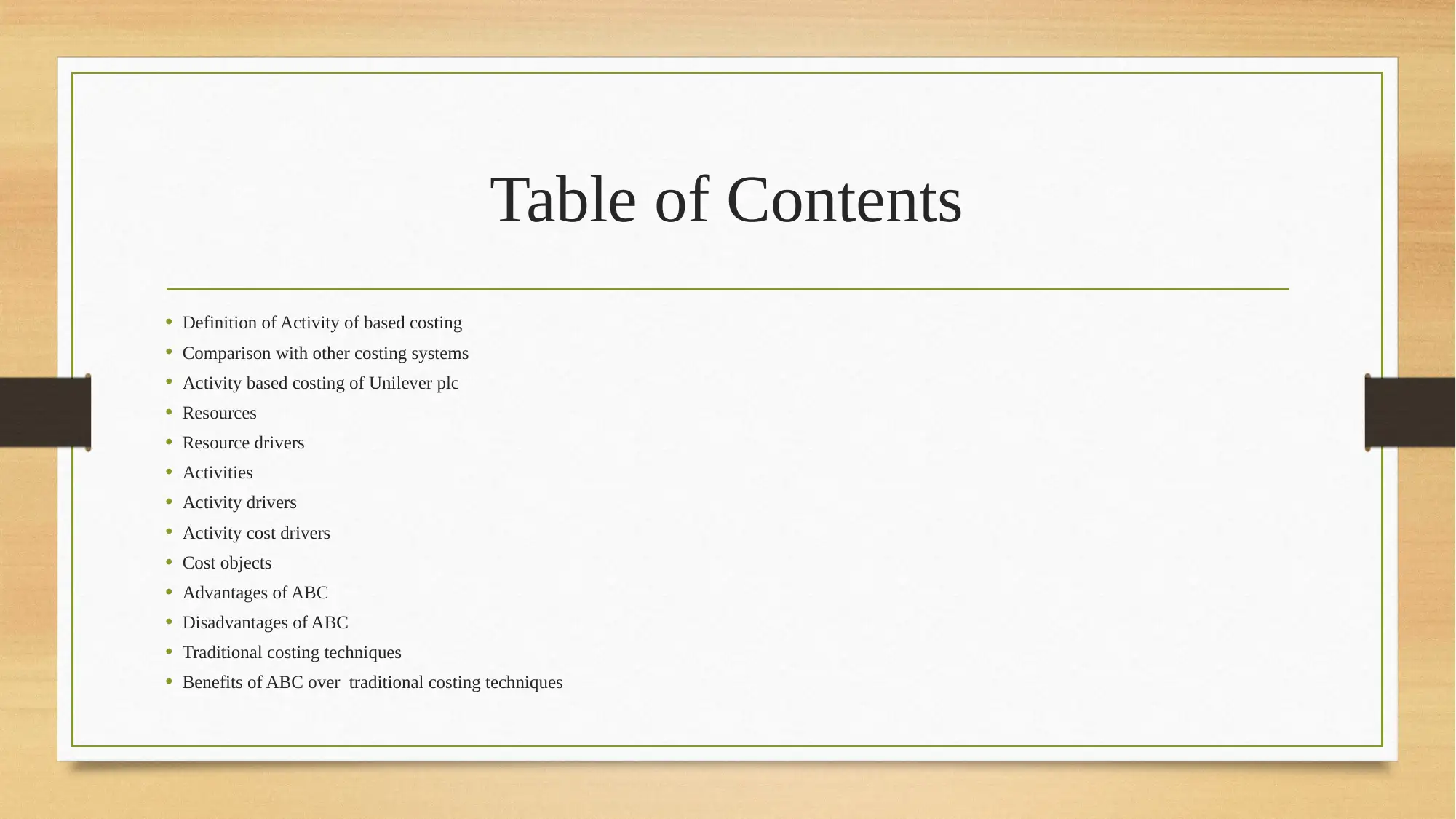
Table of Contents
• Definition of Activity of based costing
• Comparison with other costing systems
• Activity based costing of Unilever plc
• Resources
• Resource drivers
• Activities
• Activity drivers
• Activity cost drivers
• Cost objects
• Advantages of ABC
• Disadvantages of ABC
• Traditional costing techniques
• Benefits of ABC over traditional costing techniques
• Definition of Activity of based costing
• Comparison with other costing systems
• Activity based costing of Unilever plc
• Resources
• Resource drivers
• Activities
• Activity drivers
• Activity cost drivers
• Cost objects
• Advantages of ABC
• Disadvantages of ABC
• Traditional costing techniques
• Benefits of ABC over traditional costing techniques
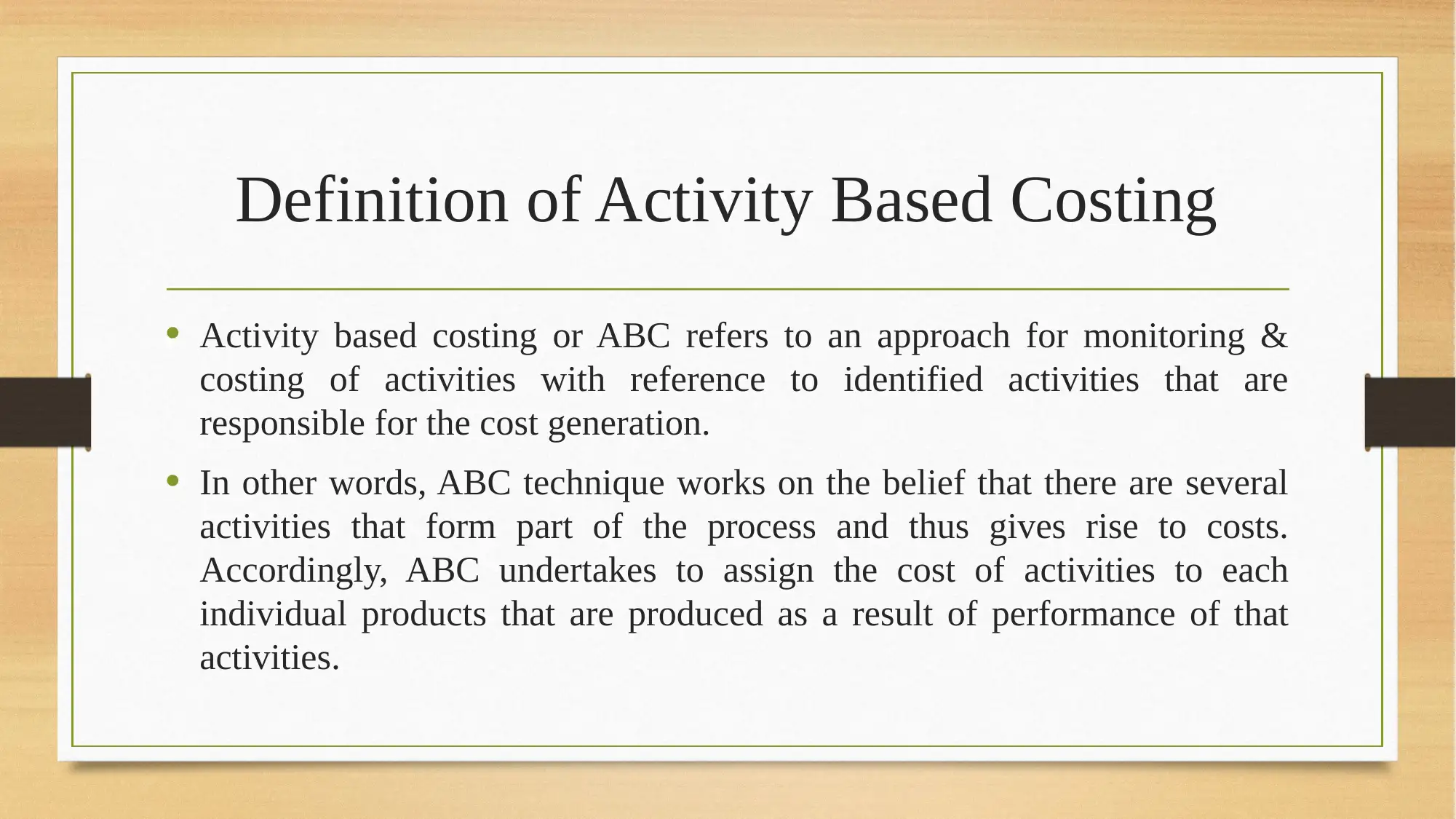
Definition of Activity Based Costing
• Activity based costing or ABC refers to an approach for monitoring &
costing of activities with reference to identified activities that are
responsible for the cost generation.
• In other words, ABC technique works on the belief that there are several
activities that form part of the process and thus gives rise to costs.
Accordingly, ABC undertakes to assign the cost of activities to each
individual products that are produced as a result of performance of that
activities.
• Activity based costing or ABC refers to an approach for monitoring &
costing of activities with reference to identified activities that are
responsible for the cost generation.
• In other words, ABC technique works on the belief that there are several
activities that form part of the process and thus gives rise to costs.
Accordingly, ABC undertakes to assign the cost of activities to each
individual products that are produced as a result of performance of that
activities.
⊘ This is a preview!⊘
Do you want full access?
Subscribe today to unlock all pages.

Trusted by 1+ million students worldwide
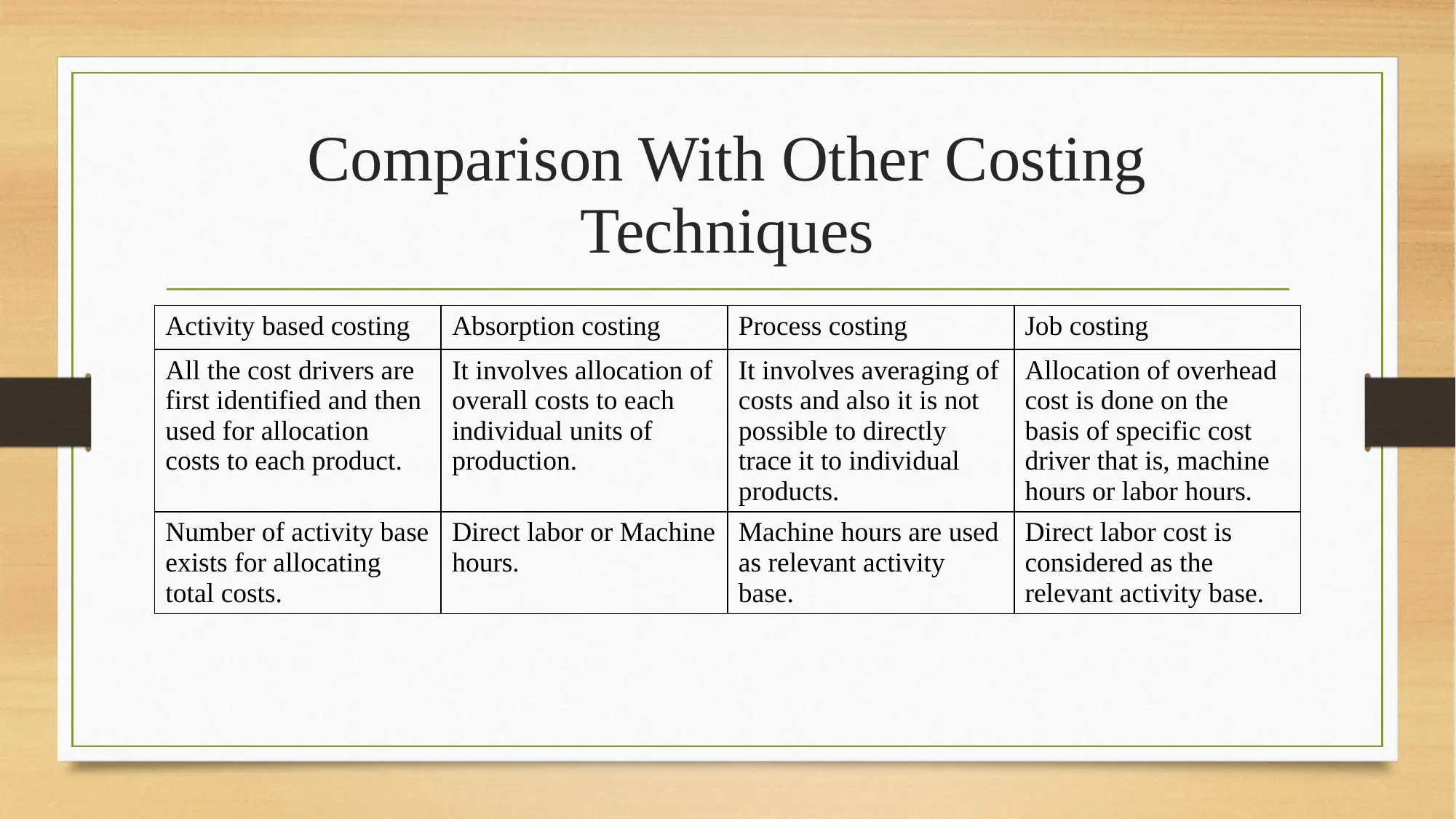
Comparison With Other Costing
Techniques
Activity based costing Absorption costing Process costing Job costing
All the cost drivers are
first identified and then
used for allocation
costs to each product.
It involves allocation of
overall costs to each
individual units of
production.
It involves averaging of
costs and also it is not
possible to directly
trace it to individual
products.
Allocation of overhead
cost is done on the
basis of specific cost
driver that is, machine
hours or labor hours.
Number of activity base
exists for allocating
total costs.
Direct labor or Machine
hours.
Machine hours are used
as relevant activity
base.
Direct labor cost is
considered as the
relevant activity base.
Techniques
Activity based costing Absorption costing Process costing Job costing
All the cost drivers are
first identified and then
used for allocation
costs to each product.
It involves allocation of
overall costs to each
individual units of
production.
It involves averaging of
costs and also it is not
possible to directly
trace it to individual
products.
Allocation of overhead
cost is done on the
basis of specific cost
driver that is, machine
hours or labor hours.
Number of activity base
exists for allocating
total costs.
Direct labor or Machine
hours.
Machine hours are used
as relevant activity
base.
Direct labor cost is
considered as the
relevant activity base.
Paraphrase This Document
Need a fresh take? Get an instant paraphrase of this document with our AI Paraphraser
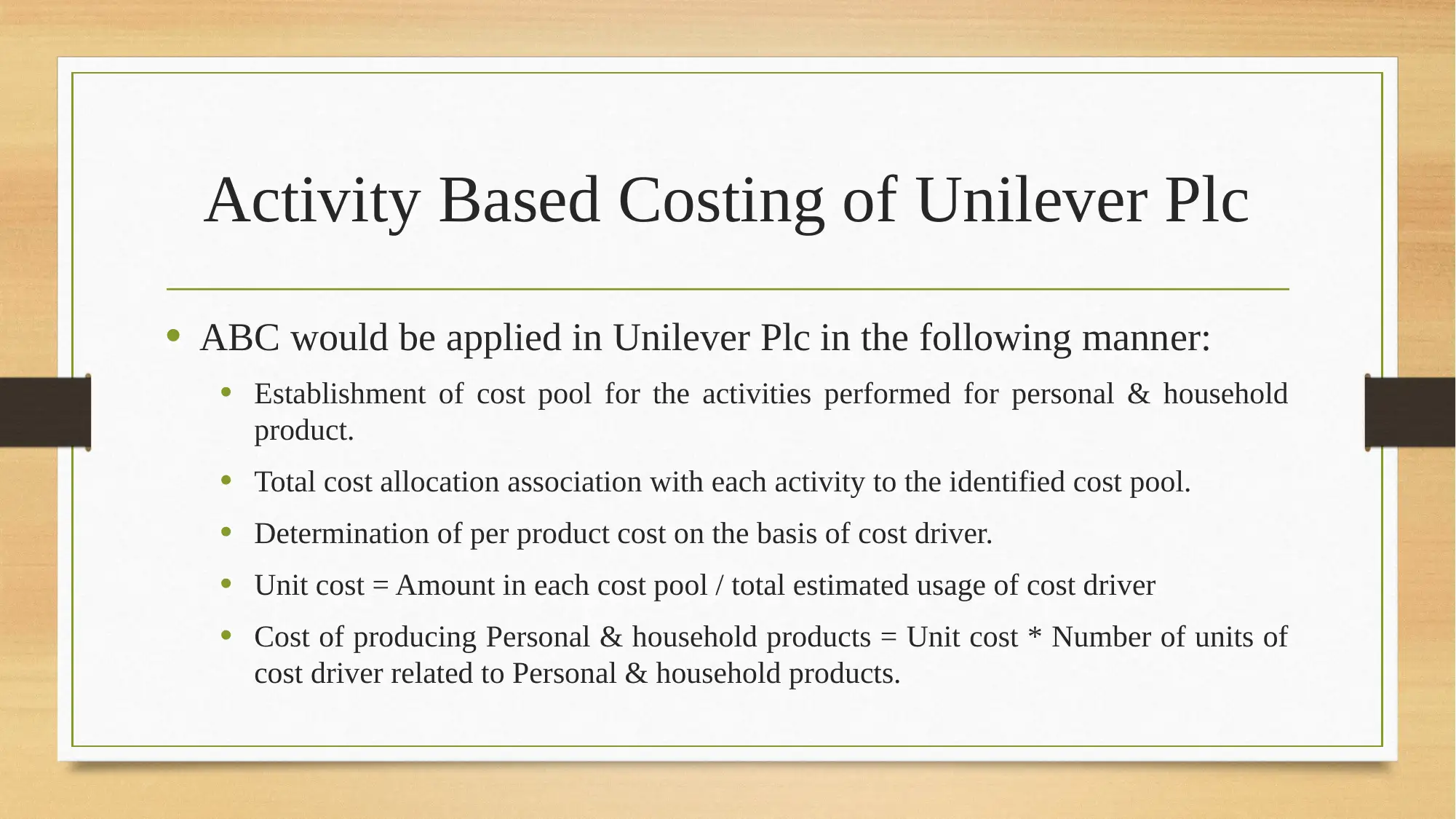
Activity Based Costing of Unilever Plc
• ABC would be applied in Unilever Plc in the following manner:
• Establishment of cost pool for the activities performed for personal & household
product.
• Total cost allocation association with each activity to the identified cost pool.
• Determination of per product cost on the basis of cost driver.
• Unit cost = Amount in each cost pool / total estimated usage of cost driver
• Cost of producing Personal & household products = Unit cost * Number of units of
cost driver related to Personal & household products.
• ABC would be applied in Unilever Plc in the following manner:
• Establishment of cost pool for the activities performed for personal & household
product.
• Total cost allocation association with each activity to the identified cost pool.
• Determination of per product cost on the basis of cost driver.
• Unit cost = Amount in each cost pool / total estimated usage of cost driver
• Cost of producing Personal & household products = Unit cost * Number of units of
cost driver related to Personal & household products.
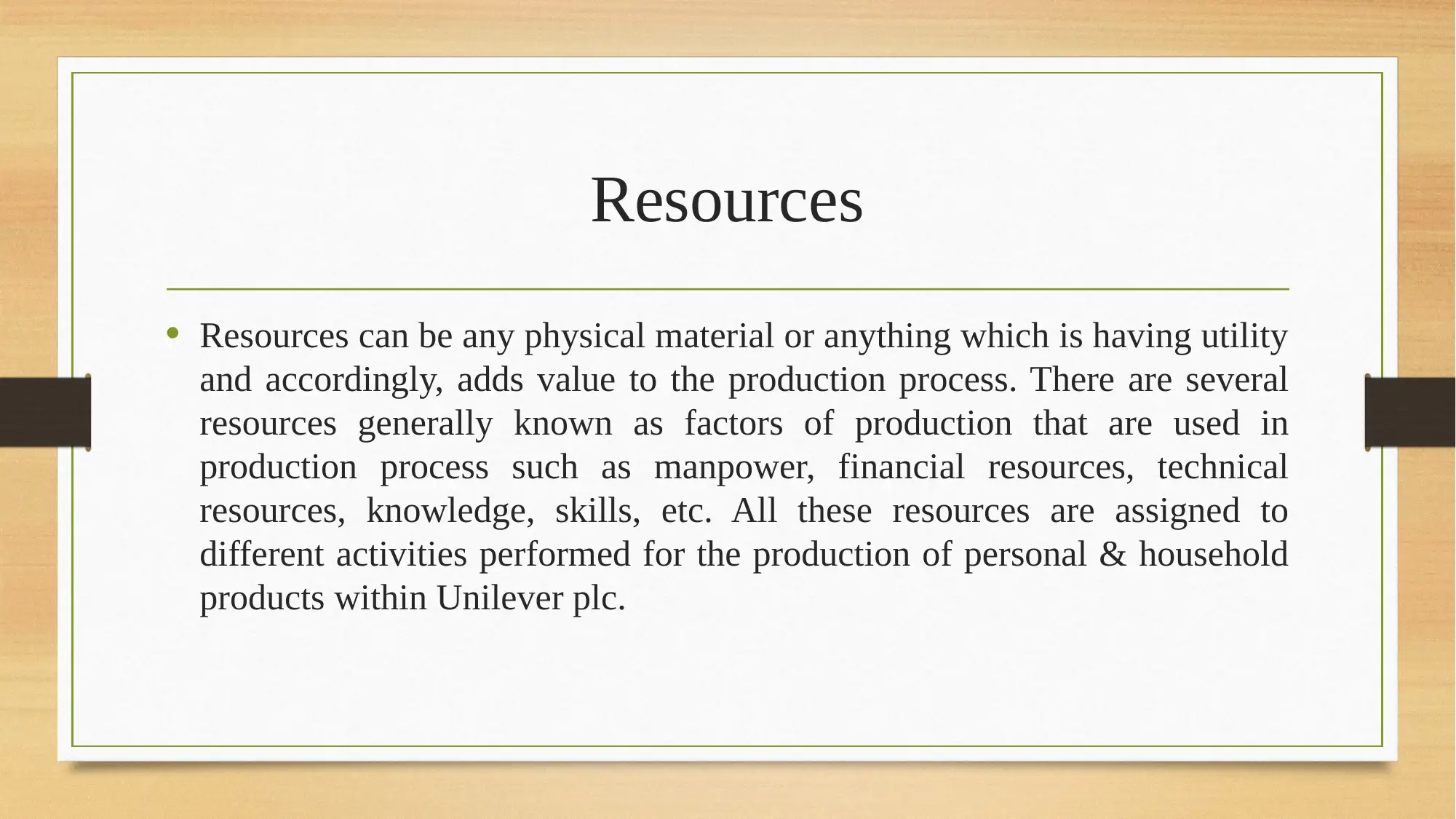
Resources
• Resources can be any physical material or anything which is having utility
and accordingly, adds value to the production process. There are several
resources generally known as factors of production that are used in
production process such as manpower, financial resources, technical
resources, knowledge, skills, etc. All these resources are assigned to
different activities performed for the production of personal & household
products within Unilever plc.
• Resources can be any physical material or anything which is having utility
and accordingly, adds value to the production process. There are several
resources generally known as factors of production that are used in
production process such as manpower, financial resources, technical
resources, knowledge, skills, etc. All these resources are assigned to
different activities performed for the production of personal & household
products within Unilever plc.
⊘ This is a preview!⊘
Do you want full access?
Subscribe today to unlock all pages.

Trusted by 1+ million students worldwide
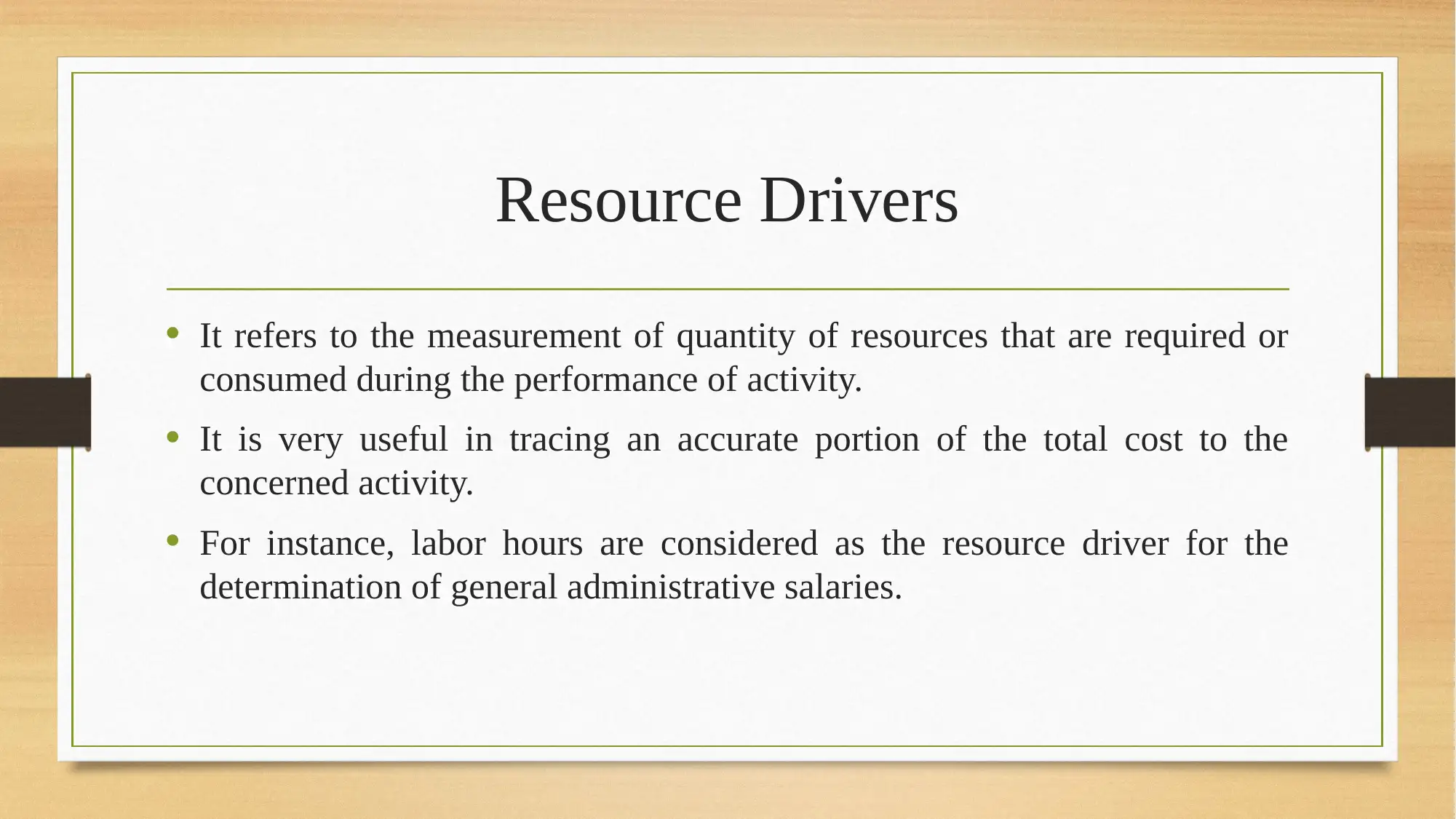
Resource Drivers
• It refers to the measurement of quantity of resources that are required or
consumed during the performance of activity.
• It is very useful in tracing an accurate portion of the total cost to the
concerned activity.
• For instance, labor hours are considered as the resource driver for the
determination of general administrative salaries.
• It refers to the measurement of quantity of resources that are required or
consumed during the performance of activity.
• It is very useful in tracing an accurate portion of the total cost to the
concerned activity.
• For instance, labor hours are considered as the resource driver for the
determination of general administrative salaries.
Paraphrase This Document
Need a fresh take? Get an instant paraphrase of this document with our AI Paraphraser
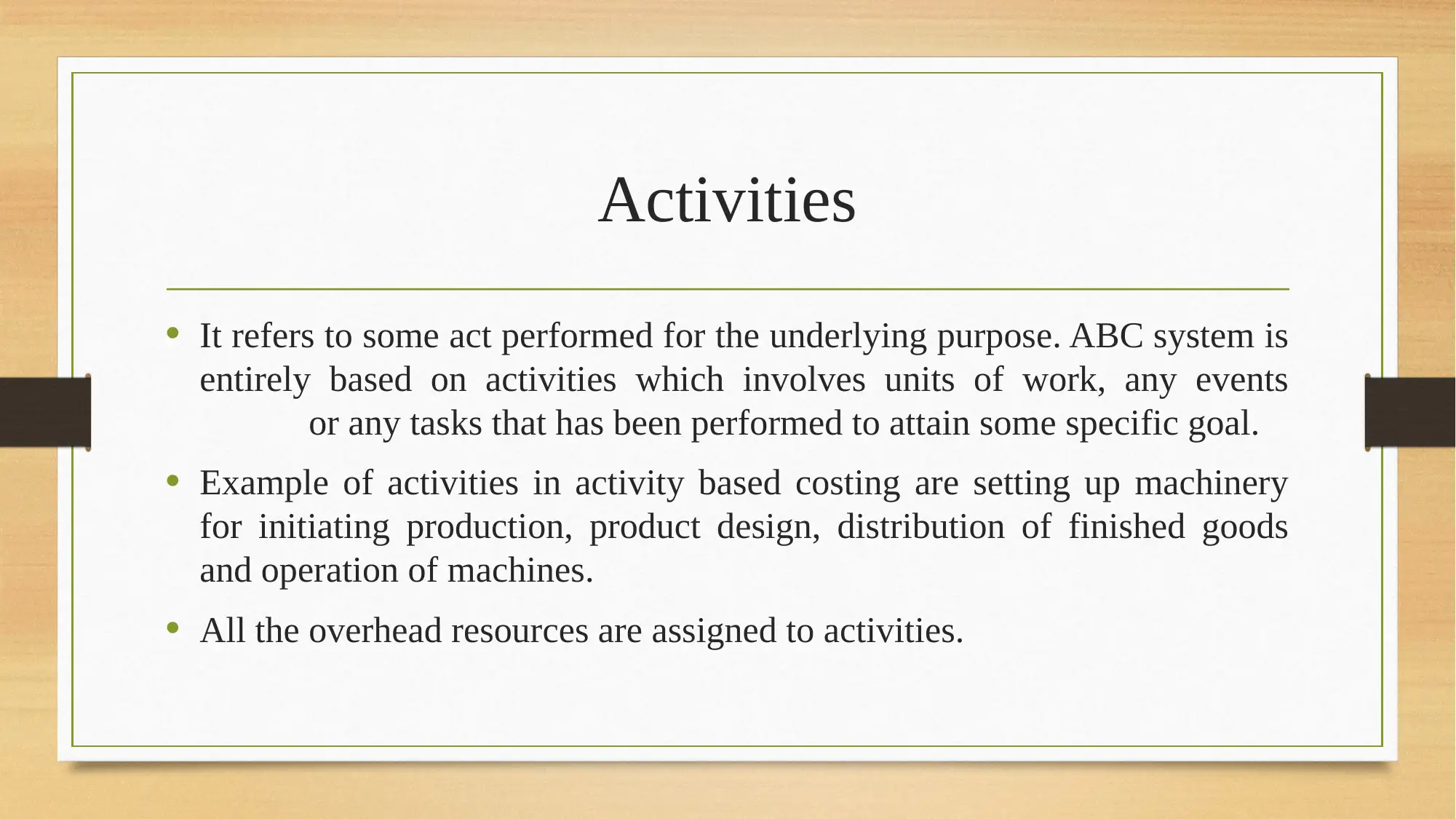
Activities
• It refers to some act performed for the underlying purpose. ABC system is
entirely based on activities which involves units of work, any events
or any tasks that has been performed to attain some specific goal.
• Example of activities in activity based costing are setting up machinery
for initiating production, product design, distribution of finished goods
and operation of machines.
• All the overhead resources are assigned to activities.
• It refers to some act performed for the underlying purpose. ABC system is
entirely based on activities which involves units of work, any events
or any tasks that has been performed to attain some specific goal.
• Example of activities in activity based costing are setting up machinery
for initiating production, product design, distribution of finished goods
and operation of machines.
• All the overhead resources are assigned to activities.
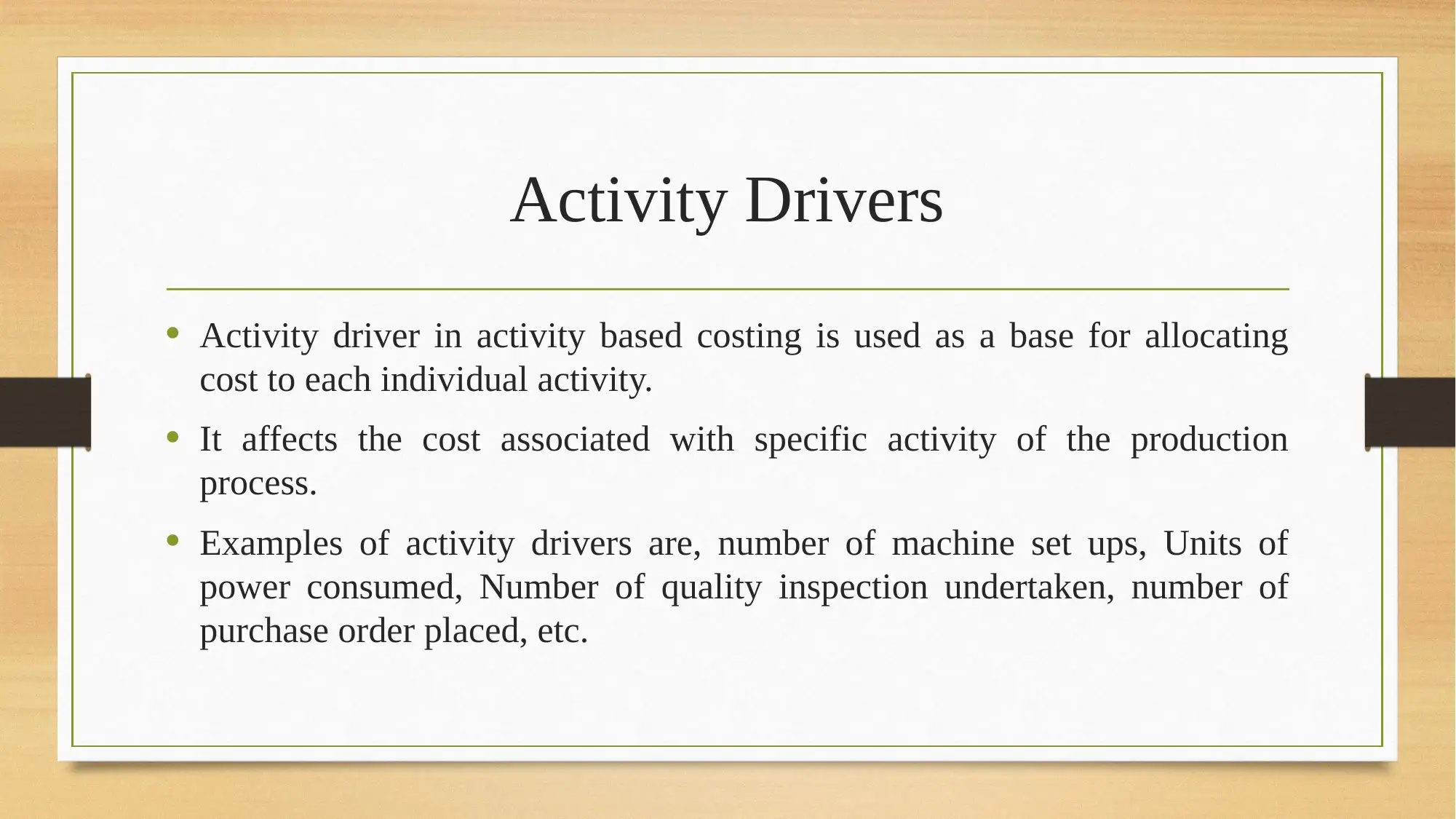
Activity Drivers
• Activity driver in activity based costing is used as a base for allocating
cost to each individual activity.
• It affects the cost associated with specific activity of the production
process.
• Examples of activity drivers are, number of machine set ups, Units of
power consumed, Number of quality inspection undertaken, number of
purchase order placed, etc.
• Activity driver in activity based costing is used as a base for allocating
cost to each individual activity.
• It affects the cost associated with specific activity of the production
process.
• Examples of activity drivers are, number of machine set ups, Units of
power consumed, Number of quality inspection undertaken, number of
purchase order placed, etc.
⊘ This is a preview!⊘
Do you want full access?
Subscribe today to unlock all pages.

Trusted by 1+ million students worldwide
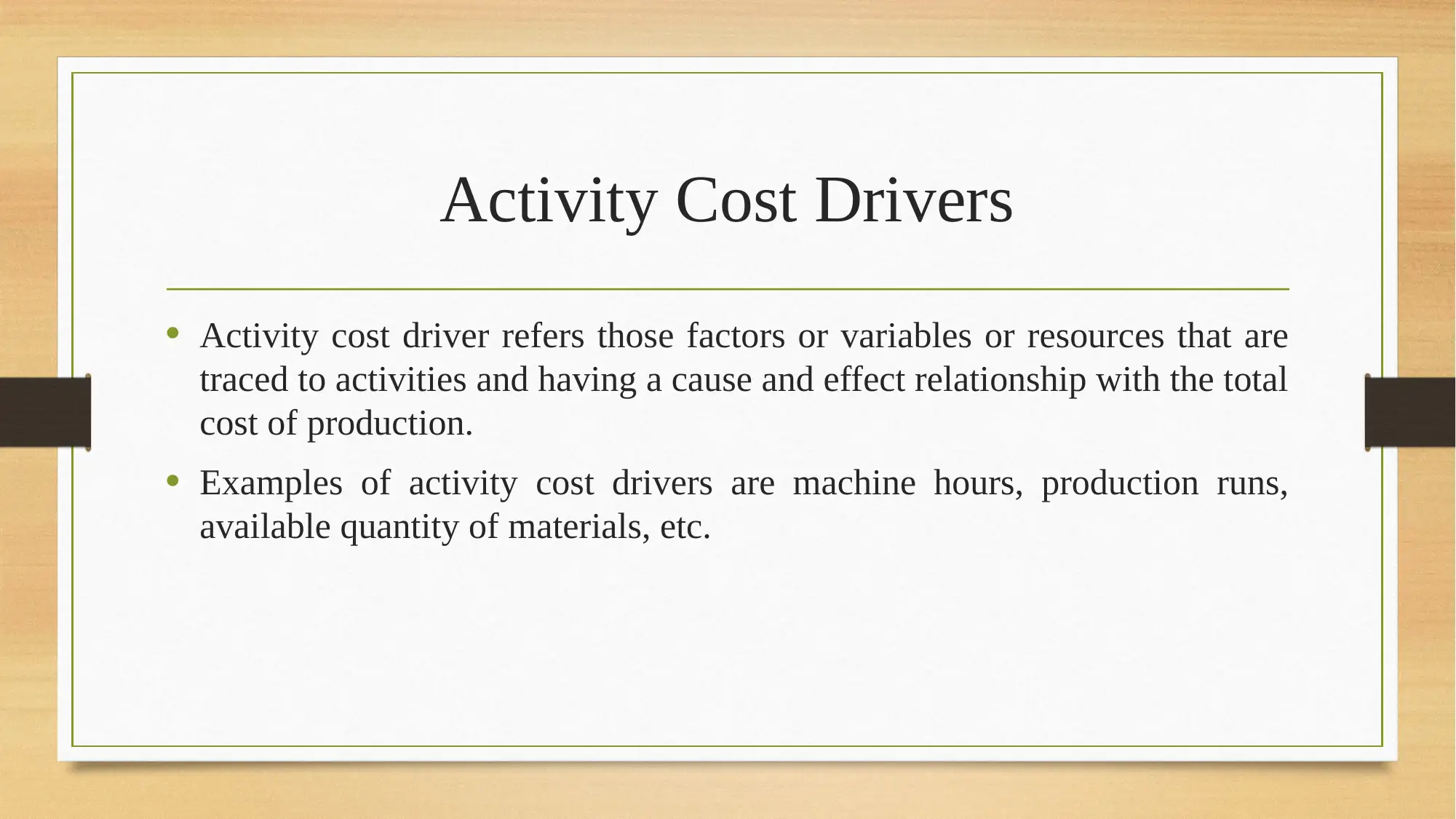
Activity Cost Drivers
• Activity cost driver refers those factors or variables or resources that are
traced to activities and having a cause and effect relationship with the total
cost of production.
• Examples of activity cost drivers are machine hours, production runs,
available quantity of materials, etc.
• Activity cost driver refers those factors or variables or resources that are
traced to activities and having a cause and effect relationship with the total
cost of production.
• Examples of activity cost drivers are machine hours, production runs,
available quantity of materials, etc.
Paraphrase This Document
Need a fresh take? Get an instant paraphrase of this document with our AI Paraphraser
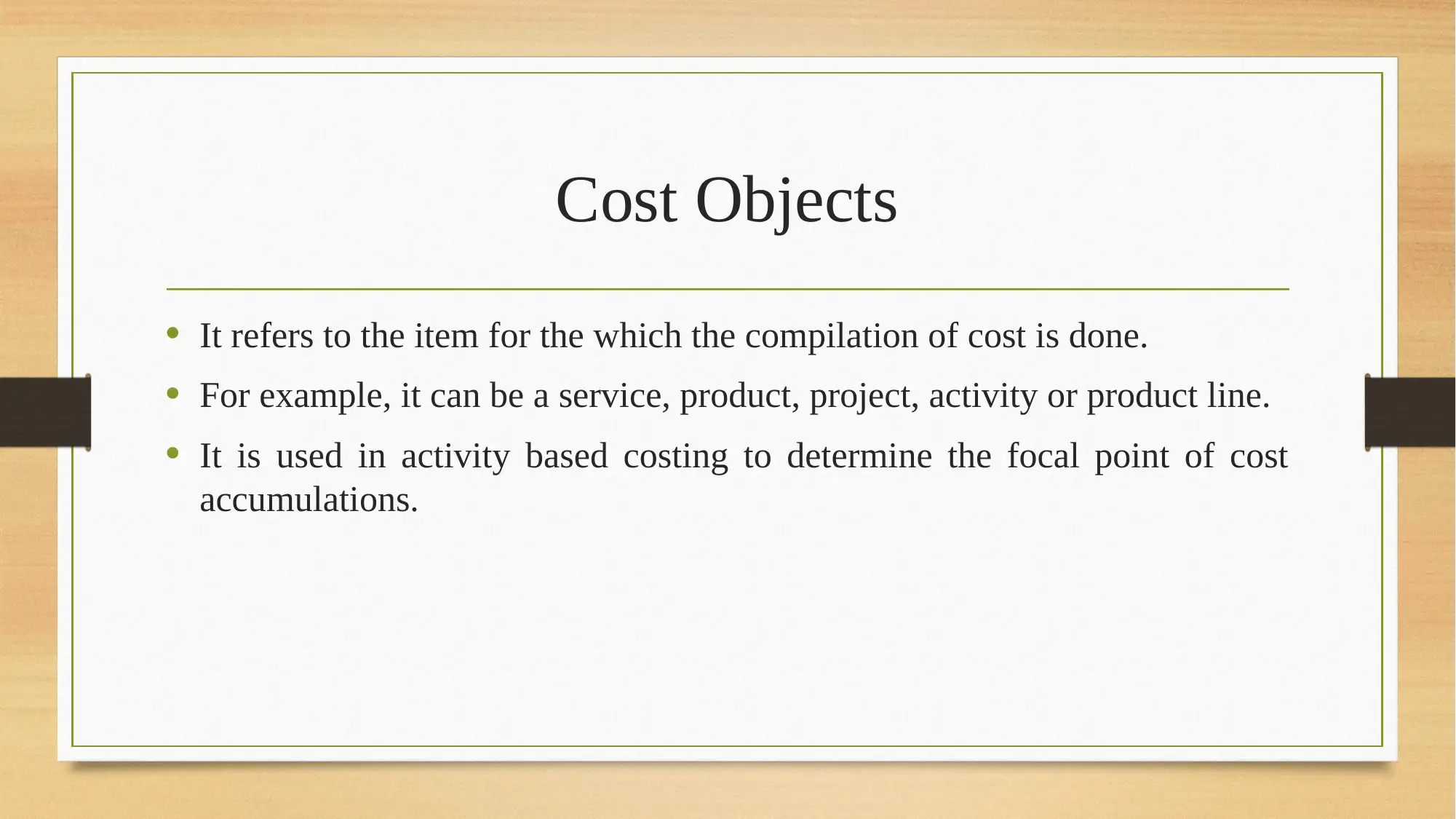
Cost Objects
• It refers to the item for the which the compilation of cost is done.
• For example, it can be a service, product, project, activity or product line.
• It is used in activity based costing to determine the focal point of cost
accumulations.
• It refers to the item for the which the compilation of cost is done.
• For example, it can be a service, product, project, activity or product line.
• It is used in activity based costing to determine the focal point of cost
accumulations.
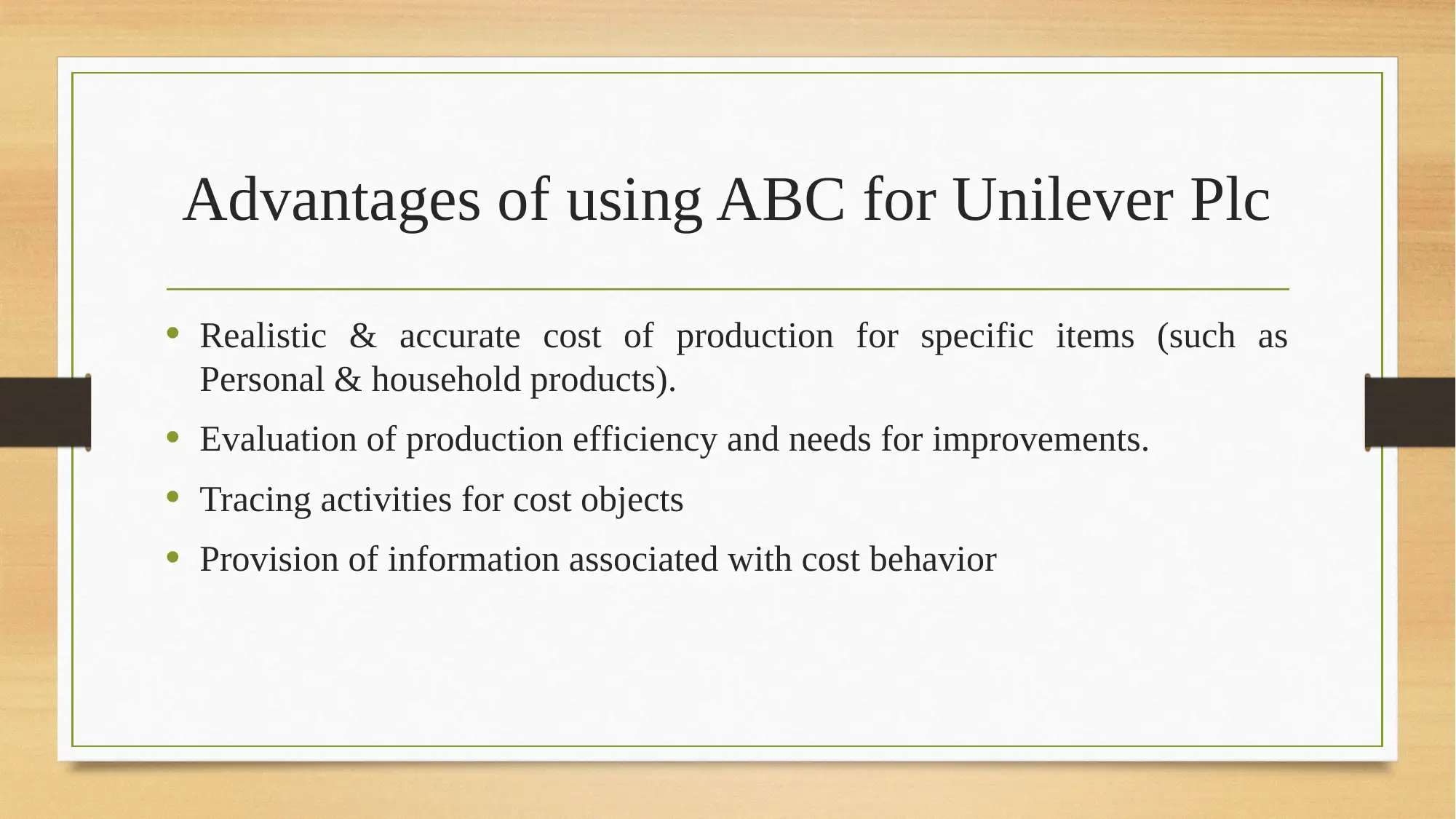
Advantages of using ABC for Unilever Plc
• Realistic & accurate cost of production for specific items (such as
Personal & household products).
• Evaluation of production efficiency and needs for improvements.
• Tracing activities for cost objects
• Provision of information associated with cost behavior
• Realistic & accurate cost of production for specific items (such as
Personal & household products).
• Evaluation of production efficiency and needs for improvements.
• Tracing activities for cost objects
• Provision of information associated with cost behavior
⊘ This is a preview!⊘
Do you want full access?
Subscribe today to unlock all pages.

Trusted by 1+ million students worldwide
1 out of 17
Related Documents
Your All-in-One AI-Powered Toolkit for Academic Success.
+13062052269
info@desklib.com
Available 24*7 on WhatsApp / Email
![[object Object]](/_next/static/media/star-bottom.7253800d.svg)
Unlock your academic potential
Copyright © 2020–2025 A2Z Services. All Rights Reserved. Developed and managed by ZUCOL.





